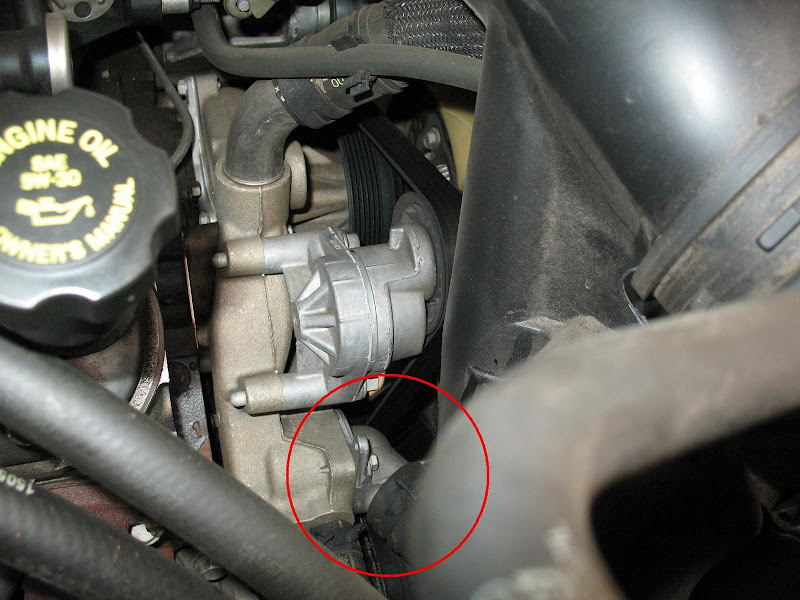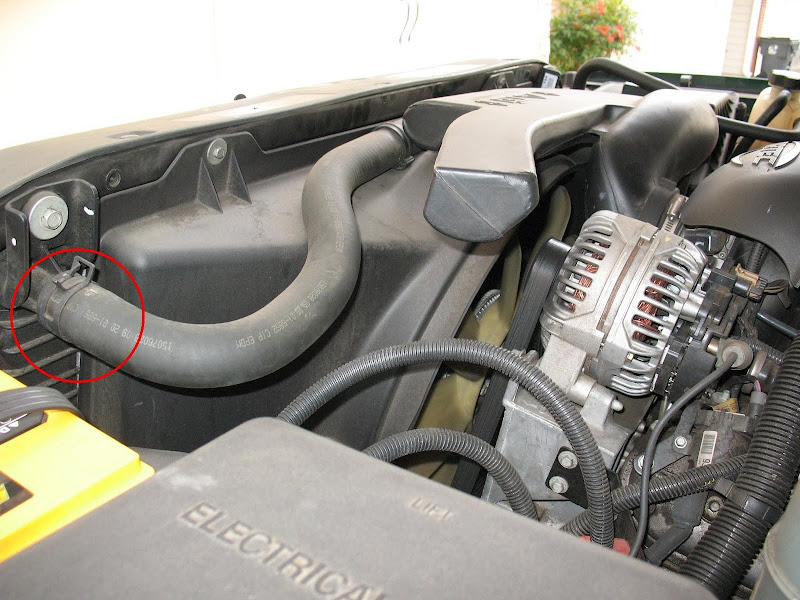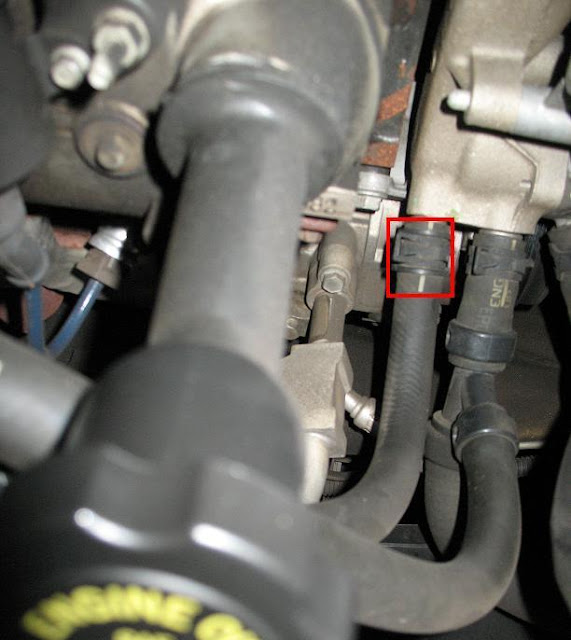It sounds like you might have a rear heater and A/C so you would need to go with 16.9 qts if so. The reason is the the radiator capacity is bigger for the extra A/C condenser heat load and an extra heater core and lines requires more coolant.
You are using an out of date browser. It may not display this or other websites correctly.
You should upgrade or use an alternative browser.
You should upgrade or use an alternative browser.
Coolant Replacement Questions
- Thread starter RoGuE
- Start date
- Status
- Not open for further replies.
RoGuE
Thread starter
Originally Posted By: mechanicx
It sounds like you might have a rear heater and A/C so you would need to go with 16.9 qts if so. The reason is the the radiator capacity is bigger for the extra A/C condenser heat load and an extra heater core and lines requires more coolant.
Is there any way to verify it? If I was premixing it all, it wouldn't matter, but I would rather not do that.
It sounds like you might have a rear heater and A/C so you would need to go with 16.9 qts if so. The reason is the the radiator capacity is bigger for the extra A/C condenser heat load and an extra heater core and lines requires more coolant.
Is there any way to verify it? If I was premixing it all, it wouldn't matter, but I would rather not do that.
RoGuE
Thread starter
I figure I'll just fill it with the amount I originally planned and top it off the few more quarts it will take to the cold line with something I premix myself.
Just to confirm:
Is this where the thermostat is on this engine? My Haynes manual is useless in telling me the location. It looks like it's held on by two bolts.

And is this the upper coolant hose I remove? (This is on the drivers side, opposite side of the engine from the coolant tank)

Just to confirm:
Is this where the thermostat is on this engine? My Haynes manual is useless in telling me the location. It looks like it's held on by two bolts.
And is this the upper coolant hose I remove? (This is on the drivers side, opposite side of the engine from the coolant tank)
Last edited:
RoGuE
Thread starter
I called the dealer for a price on the OEM thermostat and he told me it is a whole unit called a "water inlet with thermostat" and it would cost $59.60 for it. Is there a regular thermostat within this unit?
I apoligize for all these questions. I just want to be thorough.
I apoligize for all these questions. I just want to be thorough.
Last edited:
For some years the thermostat is serviced integral with the housing assembly and not available separate. I didn't even think of that. If you want to change the thermostat you can get an aftermarket assembly cheaper but I'm not sure if the quality is as good. You're probably not going to be able to flush the coolant using a hose with this setup. So you'll have to go with the multiple radiator drains or install a T-flush or unhook one of the heater hoses or drain the block through the block drains.
RoGuE
Thread starter
Multiple rad drains sounds too time consuming, and I dont know anything about the heater hoses or block drains. The T flush sounds best. Which would be easiest to do in one afternoon?
I dont have to worry about the thermostat with the T flush? And for $60 I might just leave the old one.
I dont have to worry about the thermostat with the T flush? And for $60 I might just leave the old one.
If you install a t-flush you do not have to remove the thermostat. You could do that or unhook the heater hose or the maybe the vent hose to the radiator and use an adaptor nozzle on a garden hose that would fit snuggly into the discconected hose. This diagram should show which heater hose to use. http://www.compnine.com/largeimg/980618TC08-606.gif hose #3 is the heater inlet hose.
RoGuE
Thread starter
My dad says he isn't thrilled about me cutting hoses. So I did some searching about the T flush and found this:
"If you want, you can use an extra piece of the same size hose, and install the T without cutting the original hoses, just disconnect the original hose where convenient, connect that end to the T, and connect the other end of the Tee with the extra piece of hose. Then when done, the T can be removed and the original hose reinstalled without the worry of leaving the T there. I tried leaving the T installed once, and it leaked because it got crushed and deformed by me overtightening the clamps."
So I will do that. I just don't know what line to connect it to.
Since I can't flush distilled water through this like I was planning to, once the water is coming out clear with this, how do I get the tap water out? Is opening the radiator drain and block plugs the most effective way?
And out of curiosity, how does this method work without removing the thermostat?
"If you want, you can use an extra piece of the same size hose, and install the T without cutting the original hoses, just disconnect the original hose where convenient, connect that end to the T, and connect the other end of the Tee with the extra piece of hose. Then when done, the T can be removed and the original hose reinstalled without the worry of leaving the T there. I tried leaving the T installed once, and it leaked because it got crushed and deformed by me overtightening the clamps."
So I will do that. I just don't know what line to connect it to.
Since I can't flush distilled water through this like I was planning to, once the water is coming out clear with this, how do I get the tap water out? Is opening the radiator drain and block plugs the most effective way?
And out of curiosity, how does this method work without removing the thermostat?
Last edited:
I've had T-flushes installed for years that didn't leak and it would take a real gorilla tactic to crush one. Anyway, there's nothing wrong with installing it temporarily with a short piece of hose to connect to the heater inlet. It's just extra work though.
The link I posted shows you which line is the heater inlet. It is the one without the Y-connection to the surge tank.
To get the tap water out as I explained earlier you can open the radiator drain, close it, take the cap off the T-flush (or have the inlet hose disconnected) and fill with system capacity of distilled water through the surge tank. This should displace most of the tap water in the block. You could open the engine drain plugs. But if you were going to all that bother, then you probably don't need to flush it too. The whole idea of a T-flush is to quickly and easily flush the system. Opening the block drains sort of defeats the purpose. I don't think tap water is going to be a big problem with Dexcool.
How the T-flush works with the thermostat in is it is forcing water under pressure around the thermostat and out the the surge tank. Also the directions tell you to idle the motor whiule flushing. So water is circulating in the engine and being forced out through the surge tank. So it fairly quicly flush the engine and radiator.
The link I posted shows you which line is the heater inlet. It is the one without the Y-connection to the surge tank.
To get the tap water out as I explained earlier you can open the radiator drain, close it, take the cap off the T-flush (or have the inlet hose disconnected) and fill with system capacity of distilled water through the surge tank. This should displace most of the tap water in the block. You could open the engine drain plugs. But if you were going to all that bother, then you probably don't need to flush it too. The whole idea of a T-flush is to quickly and easily flush the system. Opening the block drains sort of defeats the purpose. I don't think tap water is going to be a big problem with Dexcool.
How the T-flush works with the thermostat in is it is forcing water under pressure around the thermostat and out the the surge tank. Also the directions tell you to idle the motor whiule flushing. So water is circulating in the engine and being forced out through the surge tank. So it fairly quicly flush the engine and radiator.
I had T-flush installed in many cars without any leak. I didn't bother using distilled water in any of my cars coolant system, and I did not have any coolant related problem in 17 years 250+k miles LS400. This car had the OEM Upper hose and thermostat replaced once only at 235-240k miles last year. But several heater hoses were replaced twice in 17 years.
If you're uneasy with cutting the heater hose on the car, just buy 2 feet of the same size hose at autopart store, install the T-flush on this hose and use it to flush (after replace the heater hose on the car with it).
If you're uneasy with cutting the heater hose on the car, just buy 2 feet of the same size hose at autopart store, install the T-flush on this hose and use it to flush (after replace the heater hose on the car with it).
Originally Posted By: HTSS_TR
If you're uneasy with cutting the heater hose on the car, just buy 2 feet of the same size hose at autopart store, install the T-flush on this hose and use it to flush (after replace the heater hose on the car with it).
Now, that's a sharp idea. I think we have a winner here. I may just do that for my vehicles from now on.
My issue had nothing to do with the trust of the T-flush. I always hated fighting with attaching a stiff garden hose on a T-flush that was stationary.
If you're uneasy with cutting the heater hose on the car, just buy 2 feet of the same size hose at autopart store, install the T-flush on this hose and use it to flush (after replace the heater hose on the car with it).
Now, that's a sharp idea. I think we have a winner here. I may just do that for my vehicles from now on.
My issue had nothing to do with the trust of the T-flush. I always hated fighting with attaching a stiff garden hose on a T-flush that was stationary.
RoGuE
Thread starter
I picked up the T flush on my way home and was going to stop and get a couple feet of hose too, but then I realized I have no idea what the inside diameter is on it. Anyone happen to know what it is? I'm guessing 5/8"
RoGuE
Thread starter
Just to confirm. I'm adding the T flush to the heater inlet. And that would be the hose going into the firewall that does NOT split off into the coolant surge tank?
I'll finally be doing this today. I'll let you guys know how it goes.
(This is the one I add the T flush to?)

I'll finally be doing this today. I'll let you guys know how it goes.
(This is the one I add the T flush to?)
Last edited:
Yes, that is the one. I think it is 1/2" ID.
Remove the clamp and try 1 of the 3 T-Flushes to find which one fit the hose, buy the same size hose at autopart store in about 2 feet in case you mess up.
Remove the clamp and try 1 of the 3 T-Flushes to find which one fit the hose, buy the same size hose at autopart store in about 2 feet in case you mess up.
RoGuE
Thread starter
All done. The T-flush worked great. The only problem was I ended up with too much water in the system and I couldn't fit in my full amount of Dexcool. I had to drain some out the radiator even though it was already mixed in and had to compensate by adding a little more than necessary coolant. I think I got close enough to a 50/50 ratio.
Is there any kind of test to see if I got it right? I know there are those things with the little balls in it, but aren't there some kind of chemical test strips as well?
Is there any kind of test to see if I got it right? I know there are those things with the little balls in it, but aren't there some kind of chemical test strips as well?
Good to hear the T-flush went well. You should've drained the water from the radiator one final time before adding the anti-freeze. Also if you permanently installed the T-flush it makes it easier to displace the tap water by leaving its cap off when adding distilled water or antifreeze, but I still like to just drain the radiator to make room for the anti-freeze.
There are test strips to check the freeze point and pH of the coolant. It is an easy way to do it. Or you can get an inexpensive hydrometer at any parts store. Refractometers are the most accurate method but cost a lot and the other 2 methods should get you close enough. You should test the concentration.
There are test strips to check the freeze point and pH of the coolant. It is an easy way to do it. Or you can get an inexpensive hydrometer at any parts store. Refractometers are the most accurate method but cost a lot and the other 2 methods should get you close enough. You should test the concentration.
RoGuE
Thread starter
Darn, well that explains why I had no room left for it. lol. It was a learning experience.
And a successful one at that if the Prestone device is any indication. It showed it at EXACTLY -34 degrees on the scale (I got the one that was a dollar more that didn't have the little balls but a pointer instead). My coolant was a little lower, I guess from air escaping, so I added some more to bring it up to the cold line.
Thank you again for all your help mechanicx and everyone else who posted.
And a successful one at that if the Prestone device is any indication. It showed it at EXACTLY -34 degrees on the scale (I got the one that was a dollar more that didn't have the little balls but a pointer instead). My coolant was a little lower, I guess from air escaping, so I added some more to bring it up to the cold line.
Thank you again for all your help mechanicx and everyone else who posted.
As far as I've been able to tell those Prestone hyrometers are pretty accurate. I tested one of those Prestones first by filling with water and it read 32F then I tested with coolant against a refractometer and as I recall they were close. The refractometer is not a high quality one but as far as i know it is accurate.
- Status
- Not open for further replies.
Similar threads
- Replies
- 3
- Views
- 670
- Replies
- 7
- Views
- 342
- Replies
- 2
- Views
- 135
